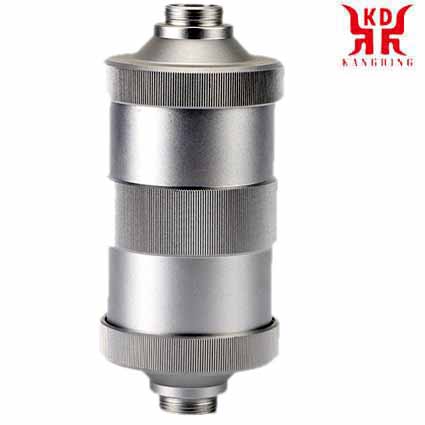Kaba olmasına rağmen, paslanmaz demir malzemelerin genel amaçlı takım tezgahlarında yarı ince talaş ve ince talaş işlemesi çok zor değildir. Fakat, yüksek kesme kuvveti sorunları nasıl çözülür, Yüksek sıcaklık, ciddi takım aşınması ve düşük dayanıklılık, Yüksek verimli özel otomatik torna tezgahında paslanmaz çelik kesiminde düşük yüzey kalitesi ve düşük verimlilik. Tek bir tornalama işleminde çizimin gerekliliklerini karşılamak zordur. Fabrikamızda martenzitik paslanmaz çelik malzemelerin CNC ile işlenmesi sürecinde: alet malzemelerinin seçiminden, takım geometrisi ve yapısının seçimi; Kesim miktarı seçimi; boş malzemenin besleme durumu; Yağlayıcıların ve soğutucuların seçimi konusunda tekrarlanan testler yapılmıştır., ve bazı başarılı deneyimler elde edildi. Örnek olarak 3Cr13 paslanmaz demiri alın.

Paslanmaz Demir Parçaların Tornalanması
Difficulties and Cause Analysis in Cutting Process
During the trial production of parts, our factory conducted a turning test on 3Crl3 steel according to the process of turning ordinary carbon steel. The result is severe tool wear, low productivity, and substandard surface quality of parts.
Comparing the mechanical properties of 3Crl3 steel with 40 çelik, 45 steel and other carbon structural steels, 3Crl3 steel has higher strength, uzama, section shrinkage, impact performance and other indicators than 40 çelik ve 45 çelik. Yüksek mukavemetli ve iyi plastikliğe sahip orta karbonlu martensitik paslanmaz çeliktir.. Due to severe work hardening, high cutting resistance and high cutting temperature during cutting, serious tool wear is caused, which increases the number of tool sharpening, increases downtime and machine tool adjustment time, and reduces productivity. And because it is easy to stick to the knife, a built-up edge is generated, which causes the change of the workpiece size and affects the surface roughness. Dahası, talaşların kıvrılması ve kırılması kolay değildir, and damage the machined surface of the workpiece, which directly affects the quality of the parts. Öyleyse, the process of cutting 45 steel cannot be used to cut 3Crl3. It is also impossible to copy the processing method of a general-purpose lathe to an automatic lathe. Because the automatic lathe has less tools, it is required that the machined surface can reach the required size and surface roughness in one pass to ensure high productivity.
Yukarıdaki sorunlara yanıt olarak, our factory has taken the following measures.
3. Main technical measures taken
1) Use heat treatment to change the hardness of the material
The different hardness of martensitic stainless steel after heat treatment has a great influence on turning. Masa 1 shows the turning situation of 3Cr13 steel with different hardness after heat treatment with a turning tool of YW2 material. It can be seen that although the hardness of martensitic stainless steel in the annealed state is low, dönüş performansı zayıf. Bunun nedeni malzemenin büyük bir plastikliğe ve tokluğa sahip olmasıdır., düzensiz yapı, güçlü yapışma ve füzyon, and is prone to knife bumps during cutting, and it is difficult to obtain better surface quality. The 3Cr13 material with hardness below HRC30 after quenching and tempering treatment has better processability and is easy to achieve better surface quality. The parts processed when the hardness is greater than HRC30, although the surface quality is good, but the tool is easy to wear. Öyleyse, after the material enters the factory, it is first quenched and tempered, and the hardness reaches HRC25 to 30, and then the cutting process is carried out.
2) Selection of turning tool materials
Under the condition of the same cutting parameters, our factory has carried out a comparison test of turning tools of several materials. Cylindrical turning tools using TiC-TiCN-TiN composite coating inserts have high durability, good workpiece surface quality and high productivity. This is because the blade of this coated cemented carbide material has better strength and toughness, and because of its surface has higher hardness and wear resistance, smaller friction coefficient and higher heat resistance. It has become a good tool material for turning stainless steel by automatic lathes, and is the first choice for external turning tools for processing 3Cr13 stainless steel in our factory. Since there is no cutting blade of this material, it can be seen from the comparison test in Table 2 that the cutting performance of YW2 carbide is also good, so the blade of YW2 material can be selected as the cutting tool.
3) Selection of the geometric angle and structure of the tool
For good tool materials, it is particularly important to choose a reasonable geometric angle.
The rake angle g0 directly affects the strength and thermal conductivity of the tool. Genel olarak, when turning martensitic stainless steel, it is more appropriate to take the rake angle of the tool from 10° to 20°. The rear angle a0 is appropriate to take 5° to 8°, and the maximum should not exceed 10°.
The blade inclination angle ls, the negative blade inclination angle can protect the tip of the blade and improve the strength of the blade. Genel olarak, g0 is selected as -10°~30°.
The main declination angle Kr should be selected according to the shape of the workpiece, the processing position and the tool loading situation.
The surface roughness of the cutting edge should be Ra0.4-0.2μm.
In the tool structure, our factory adopts the outer inclined arc chip breaker for the outer circle turning tool. The chip curling radius is large near the tool tip, and the chip curling radius is small near the outer edge. The chips turn to the surface to be machined and break, and the chip breaking is good. For the cutting knife, our factory controls the secondary declination angle within 1°, which can improve the chip removal condition and prolong the service life of the tool.
 English
English العربية
العربية 中文(漢字)
中文(漢字) Čeština
Čeština Dansk
Dansk Nederlands
Nederlands Suomi
Suomi Français
Français Deutsch
Deutsch Italiano
Italiano 日本語
日本語 ಕನ್ನಡ
ಕನ್ನಡ 한국어
한국어 Português
Português Русский
Русский Slovenčina
Slovenčina Español
Español Svenska
Svenska Türkçe
Türkçe

